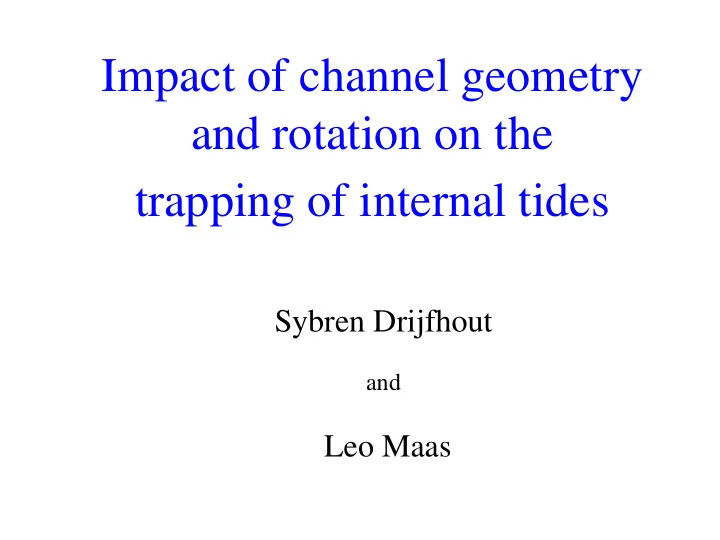

Impact of channel geometry and rotation on the trapping of internal tides Sybren Drijfhout and Leo Maas
The internal wave drag due to oscillating flow over topography: 1 = κ 2 D N h u b tide 2 The energy flux per unit area out of barotropic tides: 1 = ρ κ 〈 〉 2 2 E ( x , y ) N h u 0 b tide 2 The turbulent dissipation: ε = ρ ( q / ) E ( x , y ) F ( z ) The relation of dissipation to diffusion: Γ ε = + k v k 0 2 N
• 60 to 90% of the energy flux from barotropic to internal tides is contained in low-mode internal waves that are able to propagate large distances from the generation site • Dissipation of these low-modes waves gives rise to a canonical background mixing of k 0 = 10 -5 m 2 /s • The remaining portion, denoted as the “tidal dissipation efficiency” (q), dissipates as locally enhanced turbulent mixing • Three questions remain: (1) How important is the energy flux from the wind? (2) does q vary from site to site? (3) can the radiating low-mode waves be trapped, giving rise to sites of enhanced mixing, unrelated to local generation?
Three-dimensional effects
3D Circle: critical view depth N=const Focusing ‘Edge wave’ type on wave trapping attractor x 0 Top view
Research Question • Does geometrical trapping of internal waves exist in 3D? • Can trapping be predicted by the nondimensional parameter − ω 2 2 N H τ = 0.87 < < 1 ω − 2 2 f L
Methodology • MICOM’s 3D isopycnic model • Horizontal resolution: 3.75 km; Vertical resolution: 100 m • Channel geometry: 1200 x 191.25 km • Sponge layer in west, continental slope in east • Barotropic velocity in sponge layer forced • Bottom either flat or parabolic • f = 0, N = 3.0 10 -3 ; or, f = 10 -4 , N = 2.2 10 -3 τ = 0 . 94
Channel model
E W
N S N S
W E E W N N S S S
Conclusions • A cross-channel bottom slope constrains the penetration of the internal tidal energy due to trapping upon multiple refractions. • Near the critical depth edge-waves carry part of the energy much further away from the slope. • In case of rotation, near the shelf-slope the trapped “Poincaré wave” and southern boundary-edge wave interact, destroying the characteristics of the attractor. • The Kelvin wave along the northern slope acts as an internal wave generator.
Recommend
More recommend